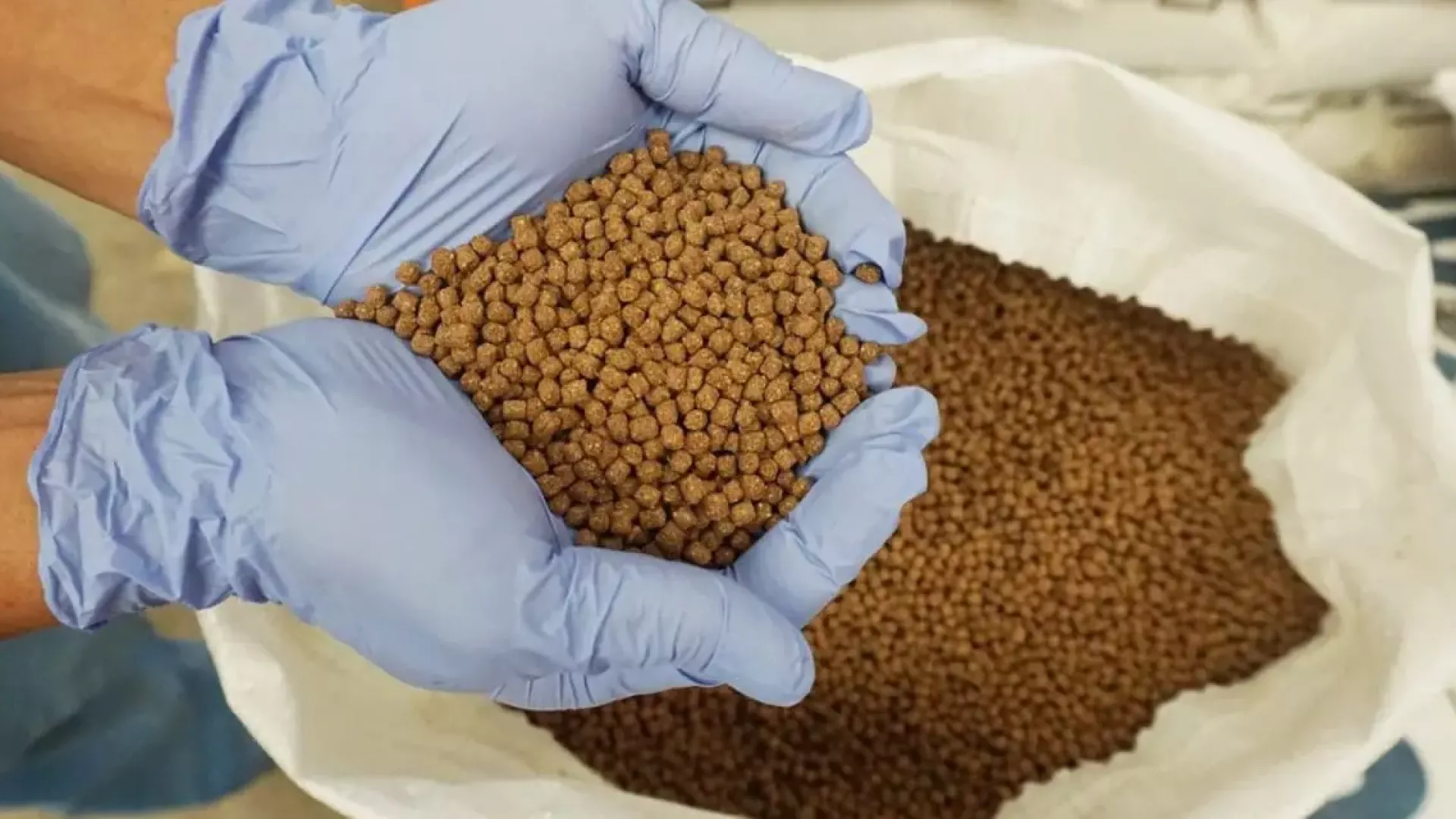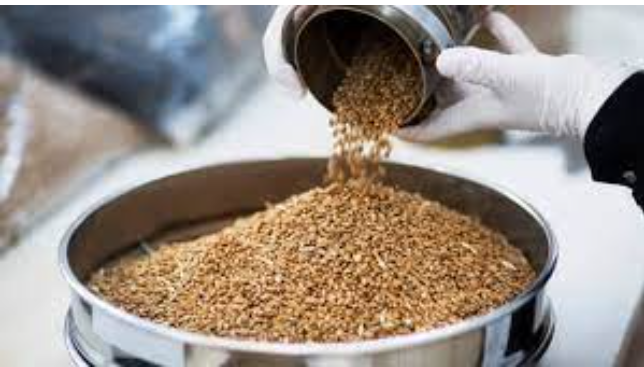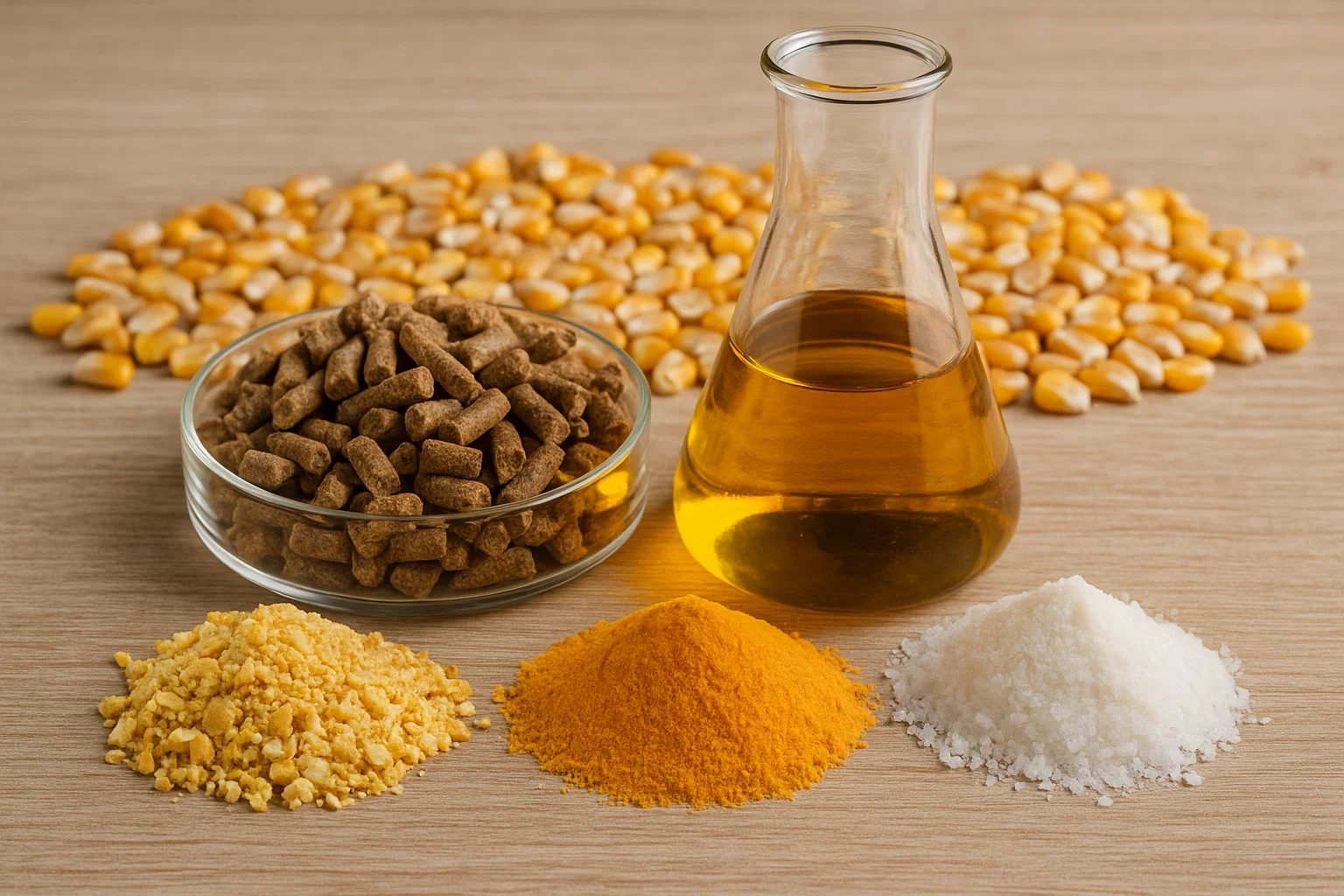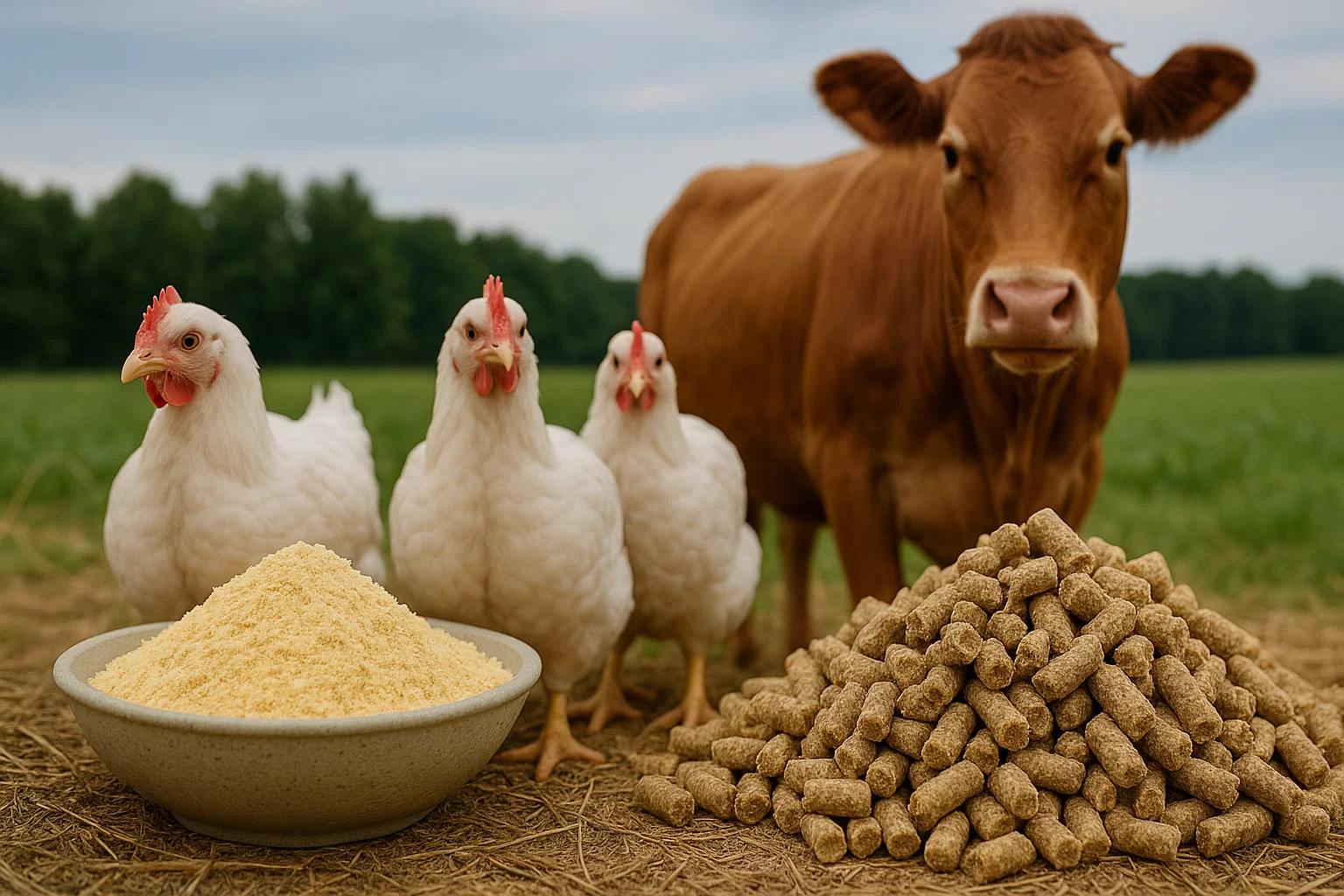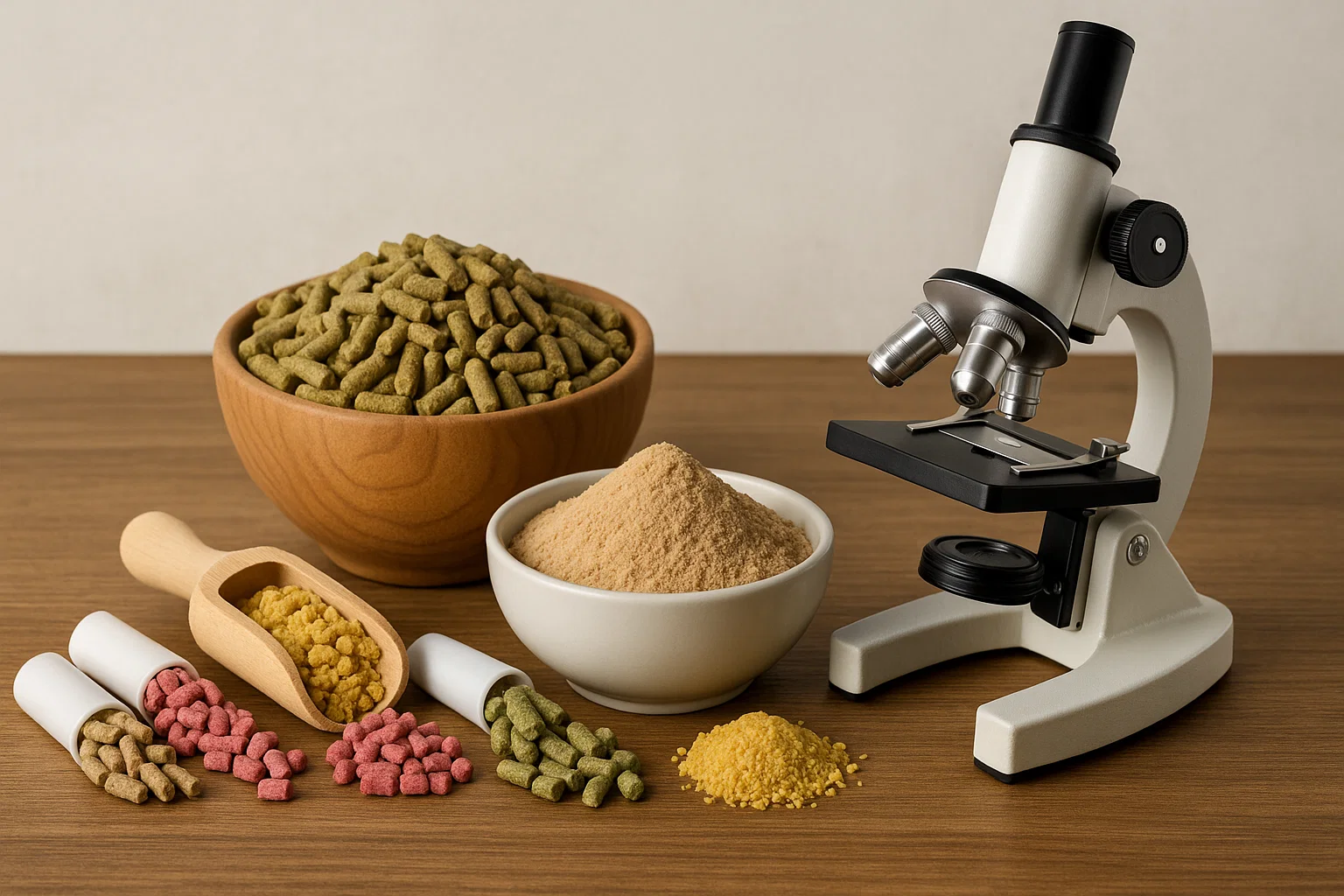In modern feed production, the focus is no longer limited to simply providing nutrition. Greater attention is now paid to the quality of the formulation and how well it meets the health and productivity needs of animals. This is where the importance of understanding the composition of feed additives becomes essential—it forms the foundation for improving the performance of livestock and poultry, enhancing immunity, and reducing mortality and production losses.
This article highlights the key components of feed additives, explains the role of each ingredient in supporting growth, digestion, and disease prevention, and provides guidance on selecting the ideal formulation based on chemical analysis and scientific criteria.
What Are Feed Additives?
Feed additives are compounds added to basic animal feed to enhance its nutritional value, improve production efficiency, and support the overall health of livestock and poultry. These additives are no longer considered optional; they have become a core part of modern feeding strategies, especially in light of increasing challenges related to climate fluctuations, environmental stress, and global market demands.
Feed additives include a wide range of substances with varying functions and effects. Some are used to compensate for deficiencies in essential nutrients—such as vitamins and minerals—while others serve to improve digestive function, like enzymes and probiotics, or to promote growth and improve feed conversion ratios.
These additives also vary by source. Some are natural, like plant extracts and live yeast, while others are synthetic, such as mineral salts and compound vitamins. In all cases, the value of the additive lies not only in its presence but in how precisely its chemical composition is formulated to align with the type of feed and the animal's specific needs.
The Importance of Chemical Composition in Additive Effectiveness
The effectiveness of any feed additive product cannot be properly evaluated without closely examining its composition of feed additives. Each ingredient in the formula plays a specific functional role, and the harmony between these components is what makes a real difference in results.
The chemical composition directly affects how nutrients are absorbed in the digestive tract and, therefore, how efficiently the animal can benefit from them. For example, if minerals like zinc or calcium are not provided in a highly absorbable form, their actual value to the animal will be significantly reduced—even if present in high concentrations.
A balance between trace elements (like selenium and manganese) and macronutrients (like calcium and phosphorus) is critical to prevent negative interactions among components. In some cases, excess of one mineral may inhibit the absorption of another, diminishing the formula’s overall effectiveness.
Several additional factors must be considered in designing a high-quality formulation:
The stability of ingredients during processing and storage.
Compatibility among compounds to avoid harmful reactions.
The biological availability and reactivity of each component.
For these reasons, professional manufacturers analyze each ingredient carefully and conduct stability and compatibility tests to ensure that the final formula performs reliably under real-world conditions.
Key Components in the Composition of Feed Additives
The quality and effectiveness of any feed additive depend heavily on the balance and harmony of its key components. A well-designed composition of feed additives should precisely meet the animal’s nutritional requirements, enhance productivity, and reduce health issues related to nutrient deficiencies or imbalances.
Below are the core components that make up most additive formulations:
1. Essential Amino Acids
Such as lysine and methionine, which are vital for muscle tissue development, improving feed conversion rates, and supporting animal growth—especially during early stages.
2. Minerals
Including iron, zinc, copper, manganese, magnesium, calcium, and phosphorus. These minerals are necessary for bone formation, enzyme regulation, and immune and reproductive functions. They are typically added in either organic or inorganic forms, depending on the application.
3. Vitamins
Such as vitamins A, D, E, and B12, which contribute to growth, immune support, and reproductive health. It is important to use heat-stable forms to preserve their effectiveness during manufacturing and storage.
4. Digestive Enzymes
Such as phytase, xylanase, and amylase, which help break down complex plant-based feed ingredients, thereby enhancing nutrient absorption and overall feed efficiency.
5. Mycotoxin Binders and Toxin Absorbers
Materials like bentonite or activated silica are added to prevent the absorption of fungal toxins from the digestive tract, protecting the liver and immune system.
6. Plant Extracts and Natural Growth Promoters
Examples include garlic, ginger, turmeric, and thyme, which are used to stimulate appetite, boost immunity, and reduce the need for traditional antibiotics.
All these ingredients are carefully selected and formulated according to the type of animal (poultry, cattle, sheep), its age, and environmental conditions.
The Difference Between Inorganic and Organic Additives
When discussing the composition of feed additives, it is important to distinguish between two main types: inorganic minerals and organic minerals. Each type differs in terms of formulation, absorption efficiency, cost, and impact on animal health.
1. Inorganic Mineral Additives
These include compounds such as copper sulfate, zinc oxide, and calcium carbonate. They are widely available, easy to manufacture, and often used in low-cost commercial feeds.
However, the primary issue with this type lies in its low bioavailability within the animal’s body, resulting in a significant portion of the mineral being excreted and not absorbed—leading to environmental pollution over time.
2. Organic Mineral Additives
These are minerals bonded with amino acids or organic compounds, such as zinc chelate or mineral methionine. They have a much higher capacity to interact with biological receptors in the digestive tract, making their absorption rate significantly better than that of inorganic forms.
Organic additives are especially preferred in situations where high nutritional precision is required, such as:
Intensive production systems.
Animals with high nutritional demands (e.g., lactating mothers or laying poultry).
Cases involving immune suppression or recovery from illness.
Beyond minerals, organic additives also include natural compounds like live yeast, probiotics, and essential oils, which serve as safe alternatives to antibiotics and contribute to sustainable herd management.
Therefore, choosing the right type of additive should depend on the intended purpose, available budget, and production conditions. While organic formulations tend to be more costly, they generally offer superior nutritional and health benefits.
How Composition Affects Nutrient Absorption
The composition of feed additives plays a crucial role in determining how efficiently nutrients are absorbed within the animal’s digestive system. It’s not just about the presence of nutrients, but also how they’re combined, their chemical form, and how they interact with one another.
1. Nutrient Balance
When formulating additives, it's essential to avoid nutrient antagonism. For example, high levels of calcium can reduce the absorption of phosphorus or zinc, resulting in a functional deficiency despite the nutrient being technically present.
2. Chemical Form of the Nutrient
Minerals come in different chemical forms, and each has its own absorption rate. For instance:
Zinc oxide is less absorbable than zinc chelate.
Copper sulfate is not as efficient as organic copper methionine.
Thus, the type of compound used largely determines how much of the nutrient the animal actually absorbs.
3. Presence of Supportive Enzymes
Some additives contain digestive enzymes that break down complex molecules like phytates, which otherwise hinder mineral absorption. Including these enzymes improves the overall bioavailability of the feed.
4. Digestive Tract pH Levels
Certain nutrients are only absorbed effectively under specific pH conditions. Some formulas include compounds that help regulate stomach acidity (pH) to enhance total nutrient uptake.
5. Bioavailability Enhancers
Advanced formulations may include helper compounds—such as organic acids or yeast extracts—that act as carriers, facilitating the transfer of nutrients from the digestive tract into the bloodstream.
Therefore, choosing a feed additive composition should not be based solely on nutrient percentages. A deep understanding of absorption dynamics and ingredient interactions is essential, because real effectiveness is measured by what reaches the animal's bloodstream—not just what's printed on the label.
Risks of Unbalanced Additive Formulations
Despite the many benefits of using feed additives, a poorly designed composition of feed additives can turn from a supportive tool into a serious source of health and productivity problems. Balance between components is not a luxury—it is a biological necessity to ensure proper animal performance and avoid long-term complications.
1. Reduced Absorption of Vital Nutrients
When the balance of vitamins and minerals is off, certain elements may interfere with the absorption of others. For example, excess iron can suppress the absorption of zinc and copper, leading to indirect deficiencies even when nutrient levels appear adequate.
2. Toxic Element Accumulation
Some elements, such as selenium or copper, are effective only within narrow dosage ranges. Overuse can lead to chronic toxicity, with harmful buildup in the liver or tissues, impairing growth and, in severe cases, causing mortality.
3. Hormonal and Immune Imbalances
Excessive levels of certain vitamins—like A or D—can lead to hormonal disorders or immune suppression, making animals more susceptible to diseases and reducing fertility.
4. Decline in Production Quality
An unbalanced formula can have immediate negative effects on productivity, including:
Lower daily weight gain.
Higher feed conversion ratio (meaning lower efficiency).
Reduced quality of eggs, milk, or meat.
5. Difficult Diagnosis and Troubleshooting
One of the most dangerous effects of a poor formula is that issues don’t always appear immediately, making root cause identification challenging. Often, the feed or the animal’s condition is blamed, while the real issue lies in a subtle chemical imbalance within the additive.
That’s why modern studies strongly recommend testing each batch of additives and carefully reviewing the chemical analysis before use, to ensure compatibility with the specific feed, animal type, and production environment.
Tips for Choosing the Ideal Feed Additive Composition
Selecting the right composition of feed additives is not a random decision—it requires technical insight and a clear understanding of the herd’s needs, feeding conditions, and feed type. Here are practical tips to help you make an informed choice:
1. Start by Defining the Nutritional Goal
Is the additive meant for growth promotion, immune support, or enhancing productivity? Each goal requires a distinct set of nutrients, which guides the choice of the right product.
2. Choose Scientifically Validated Products
Always work with companies that provide documented field results demonstrating the effectiveness of their products under conditions similar to yours. A Certificate of Analysis (COA) is essential.
3. Review the Nutrient Ratios in the Formula
Don't be misled by the number of ingredients—focus on the ratios and their balance with the base ration. Ensure vitamins and minerals are present in the proper chemical forms for absorption.
4. Verify the Type of Compounds Used
Ask questions: Are the elements provided in organic or inorganic forms? Are the enzymes heat-stable? Are the vitamins coated or protected? These details can significantly impact the product’s effectiveness.
5. Consider the Animal’s Age and Type
The needs of poultry differ from those of cattle, and young animals require different support than adults. A formula suited for fattening lambs may not work for dairy cows.
6. Use a Complementary Nutrition Strategy
If using multiple additives, ensure no nutrient redundancy or antagonism. Coordinate them to create a synergistic, not conflicting, nutritional plan.
In conclusion, the composition of feed additives plays a critical role in the success of any livestock production system. These additives are not merely supplementary substances—they are strategic nutritional tools that determine product quality, animal health, and farm profitability.
Every ingredient in the formula serves a purpose, and every balance between components directly influences nutrient absorption, digestive efficiency, and immune strength. With advancements in nutritional science, it is now possible to develop highly precise formulas tailored to each species, age group, and environmental condition.
Therefore, farmers and producers must have a solid understanding of the chemical composition of the products they use and rely on trustworthy suppliers and scientific analysis before selecting any additive.

